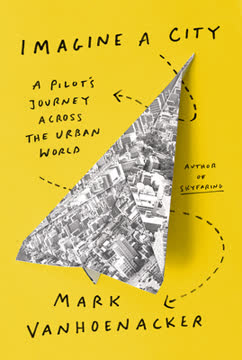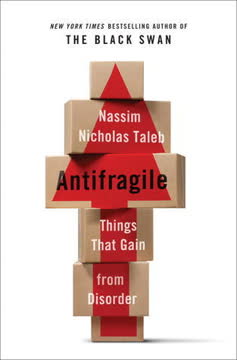Key Takeaways
1. A Pilot's Unique Urban Lens
Long-haul airline pilots today are given an experience of cities that no one else in history has ever had.
Unparalleled perspective. As a long-haul pilot, the author experiences cities from a truly unique vantage point, often observing dozens of glowing urban centers from above, especially after dark. This aerial view transforms cities into bioluminescent tapestries, revealing their fragility and interconnectedness across vast distances. The descent at daybreak further unveils how wilderness gives way to sprawling metropolises, offering a map-like view of awakening streets.
Frequent, short stays. Unlike typical travelers, pilots experience cities through short but frequent "down-route" stays, usually around 24 hours. This allows for repeated, fine-grained exploration or, conversely, a shallow, insulated experience depending on personal interest or fatigue. This rhythm of arrival and departure creates a distinct relationship with each city, fostering a sense of deceptive familiarity.
Global urban tapestry. The pilot's career offers an extraordinary glimpse into the urbanized future of civilization, witnessing cities grow and change before his eyes. This perspective highlights:
- The increasing demographic supremacy of the urban planet.
- The heterogeneous and predominantly non-Western character of global cities.
- The humbling realization that even extensive travel reveals only a fraction of the world's urban centers.
2. Hometown as a Foundational Map
But mostly I think that Pittsfield’s role in my life is like that of a first language, one that I’ve no choice but to turn to when I’m trying to make sense of other places.
An indelible lens. The author's small hometown of Pittsfield, Massachusetts, serves as an enduring "first language" or lens through which he perceives and understands every other city he encounters. Whether assessing distances in Bangalore by comparing them to walks in Pittsfield or orienting himself in New York by recalling his childhood bedroom window, his hometown remains a constant, shaping his urban perceptions.
Complicated relationship. Growing up, Pittsfield was a place of hidden struggles—a speech impediment, his dawning awareness of being gay, and his parents' divorce—leading him to dream of faraway, effortless cities. Yet, after leaving, he realized that many of his difficulties accompanied him, and that Pittsfield itself, with its supportive community and infrastructure, had made his departure and subsequent life possible.
Return and reconciliation. Despite his initial eagerness to leave, the author's extensive travels paradoxically intensify his love for Pittsfield. He frequently returns, cherishing the familiar faces and places, and even dreams of retirement near it. This ongoing relationship offers a repetitive lesson in how two opposed feelings—a desire to escape and a deep affection—can coexist, ultimately leading to a profound understanding of his roots.
3. Cities as Mirrors of Personal Dreams
My city is where I travel to when I’m sad or worried, or when I don’t wish to think about what I don’t like about myself, such as the fact that I’m unable to pronounce the letter r, and therefore many words, including my own name.
Escape and solace. From a young age, the author's imaginary city served as a refuge from personal anxieties, including a debilitating speech impediment and the dawning awareness of his sexuality. This mental escape provided solace during difficult times, whether doing chores, enduring boring classes, or struggling with sleepless nights. The imagined city was a perfect place where his troubles didn't exist.
Shaping identity. The desire for effortless speech and acceptance fueled a fascination with foreign languages and distant cities, where he believed life would be simpler. This quest for a place where "being myself... would occur effortlessly" became a driving force, intertwining his personal identity with his urban explorations. His dreams of cities were deeply personal, reflecting his internal landscape.
Dreams made real. The book highlights how these childhood imaginings sometimes eerily manifest in reality. His recurring dreams of the "North Dallas Tollway" before ever visiting Dallas, or the "Palace of Dawn" in Brasília, a city shaped like an airplane, demonstrate the powerful, almost prophetic, connection between his inner world and the external urban environment. This suggests that the distinction between dreams and reality, especially concerning cities, can be fluid.
4. Nature's Indelible Mark on Urban Identity
All cities—so often built along rivers, or on natural harbors so faultless as to seem fated, or at the intersections of roads or rails themselves steered by topography—are sculpted by nature before they are by people.
Topographical destiny. Cities are fundamentally shaped by their natural environment, from the rivers they rise beside to the mountains that cradle them. This natural sculpting dictates not only their initial placement but also their growth, infrastructure, and even their character. The author observes this in:
- Pittsburgh, arising at the intersection of three rivers.
- Seoul, with its geomantically balanced Han River and restored Cheonggyecheon stream.
- Cape Town, dominated by Table Mountain and its surrounding oceans.
Sensory experience. Beyond their physical form, natural elements profoundly influence the sensory experience of a city. The "golden, gauzy air" of Kuwait, the "chilly and overcast" weather of Calgary, or the "fierce" winds of Copenhagen are integral to their identity. These atmospheric conditions impact everything from daily life to aviation, making the air itself a tangible, defining feature.
Human-nature interplay. While nature sculpts cities, humans constantly reshape and adapt to it. The Los Angeles Aqueduct, diverting water from the Owens Valley, or Seoul's Cheonggyecheon stream, artificially pumped to flow, exemplify humanity's monumental efforts to harness or recreate nature within urban settings. This ongoing dialogue between the natural and the artificial defines the unique character of each metropolis.
5. The Poetic Resonance of City Names and Signs
I love signs because of the contrast between how indirectly their power functions and how considerable that power can be.
Names as narratives. City names, whether ancient or modern, carry profound historical and personal weight. From the straightforward "Cape Town" (a cape, a town) to the evocative "Las Vegas" (mistakenly imagined as "bright star Vega"), names shape perception and conjure entire worlds. The author's fascination extends to names like "Nieuw Amsterdam" or "New Orleans," which reveal layers of history and migration.
Signs as silent guides. Road signs, even unlit or unread for hours, exert a powerful, almost gravitational pull, charting a city's influence across its hinterlands. The concept of "control cities" on highways, or the simple "TRAIN TO CITY" signs in airports, illustrate how these markers guide travelers and define urban boundaries. They are both practical and poetic, silently directing millions.
Hidden meanings. Beyond their literal function, signs and names often hold deeper, sometimes forgotten, meanings. The "Berkshire Athenaeum" in Pittsfield, whose name conceals the goddess Athena, or the "Yamanote Line" in Tokyo, meaning "in the direction of the heights," reveal layers of cultural and historical significance. These linguistic and visual cues enrich the urban experience, inviting deeper contemplation of a city's past and identity.
6. Gates as Symbols of Urban Protection and Transition
For me, the sense of both greatness and protection that gates conjure remains so beguiling that whenever I see a map of a city, especially those European and Asian ones old enough to have needed walls, my eyes are drawn to gate-names first.
Ancient promise of safety. City gates, whether still standing or existing only in names, evoke a primal sense of protection and boundary. Historically, walls and gates were essential for defense, holding off invaders and entropy. Today, their remnants or names—like London's Moorgate or Jeddah's Mecca Gate—continue to symbolize a city's enduring strength and its capacity to offer refuge.
Portals of transformation. Gates mark points of entry and departure, signifying transitions. The author's personal experience of passing through gates, from the unnamed ones on Pittsfield's hills to the grand Bab al-Furda in Jeddah, reflects his own journeys of self-discovery and change. These thresholds represent both physical passage and metaphorical shifts in identity and belonging.
Cultural and historical markers. Gates are deeply embedded in a city's cultural fabric, often lending their names to neighborhoods, streets, and stations. They tell stories of:
- Cities named for other distant cities (Delhi Gate in Aurangabad, Damascus Gate in Jerusalem).
- Rituals of opening and closing, reflecting ancient curfews and trade routes.
- The evolution of urban planning, from fortified enclosures to modern ring roads.
These historical layers transform mere architectural features into powerful symbols of urban identity.
7. The Paradoxical Comfort of Global Familiarity
Indeed, in some cities this familiarity is so powerful and deceptive that I’ve struggled to remind myself: I am not from here. This city is not mine.
Deceptive belonging. The author's frequent, short visits to numerous cities create a curious and powerful sense of familiarity, making him feel momentarily "at home" in places like Los Angeles or São Paulo. This feeling is so pervasive that he sometimes struggles to remember he is not a native, experiencing a "place lag" that blurs the lines between his transient presence and a deeper sense of belonging.
Universal urban patterns. This widespread familiarity stems from the shared "grammatical arrangements" of urban forms—parks, libraries, intersections, skyscrapers—that recur across different metropolises. While each city is unique, they also share common elements that make them recognizable and navigable, even to a frequent visitor. This highlights the underlying archetypal nature of cities.
Reinforcing home. Paradoxically, this global familiarity ultimately strengthens his connection to Pittsfield. The more cities he experiences, the more he understands his hometown as a unique, foundational reference point. Encounters with diverse urban cultures, rather than alienating him, often return his thoughts and heart to his small, first city, affirming its singular role in his life.
8. Air as a Defining Urban Element
The problem, when you only imagine a place, and especially when you do so alone, is that there’s no one to point out such obvious omissions; there are no helpful friends or stern inspectors to tap you on the shoulder and warn you: Your city has no air.
A city's breath. The author realizes that his childhood imaginary city lacked a crucial element: air. As a pilot, he becomes acutely aware of the tangible qualities of a city's atmosphere—its winds, humidity, and temperature—which profoundly shape urban life and flight. This sensory dimension is often overlooked but is fundamental to a city's identity.
Hot and high challenges. Cities like Nairobi, Mexico City, and Denver present "hot and high" conditions, where thinner, hotter air impacts aircraft performance, requiring longer runways and different flying techniques. This meteorological reality makes the air a critical operational factor, transforming it from an invisible medium into a palpable force.
Climate and culture. A city's air influences its culture and architecture. Kuwait, one of the hottest cities on Earth, developed ingenious "wind catchers" and traditional houses designed for natural cooling, long before modern air-conditioning. The golden, dusty haze of Kuwait's sky, often obscuring the ground, becomes a defining visual and sensory characteristic, reflecting both its desert environment and the challenges of climate change.
9. Blue as the Color of Urban Hope and Journey
There’s a calmness to the blues that I’m most drawn to, and a depth and a vastness that are indistinguishable from those same qualities in the sky and the sea; and so it must be that blue embodies or intensifies the hope I long ago placed in journeys.
A personal obsession. Blue is the author's favorite color, deeply intertwined with his identity and his love for flight and cities. He sees it everywhere:
- The "dream of blue, cloud-mirroring glass" of Boston's Hancock Tower.
- The "richly marine-hued parallelograms" of light in Petrópolis's Crystal Palace.
- The "bluest city I know," Cape Town, with its skies, seas, and even its mountains reflecting the color.
This personal connection makes blue a symbol of hope and the allure of distant journeys.
The science of blue. The book delves into the scientific reasons for blue skies and oceans, explaining how shorter wavelengths of light scatter more effectively in air and penetrate water more deeply. This scientific understanding enhances the appreciation of blue's "grandeur and its dazzling purity," linking the romantic and the rational aspects of the color.
Blue as a universal language. Pilots, almost universally, share a love for blue, often signing off emails with "blue skies." This shared appreciation highlights how the color, so dominant in the aerial view, transcends individual preferences to become a professional and even spiritual motif. In Cape Town, the "most magnificent blues" are a source of pride and identity for its residents, despite the city's complex history.
10. Snow as a Transformative Urban Blanket
I imagine I first came to love snow only because heavy overnight storms saved me from having to go to school, and from confronting the challenges that lived there.
Childhood escape. For the author, snow was initially a welcome escape from the difficulties of school and personal struggles in Pittsfield. The idea of a "permanent winter" in Narnia, or the "snowy fields on the edges of Pittsfield," offered a sense of solace and transformation, turning the familiar world into a magical, quiet realm.
Urban disruption and resilience. Snow dramatically alters city life, from the "crippling" blizzards of London and Istanbul to the routine, heavy snowfall of Sapporo. It challenges urban infrastructure, requiring specialized snow clearance and de-icing, but also reveals a city's resilience and the ingenuity of its inhabitants. The "Mama-san Danpu" shovels of Sapporo exemplify this adaptation.
Sensory and emotional impact. Snow brings a unique sensory experience—the silence it imparts, the way it obscures familiar landscapes, and the paradoxical warmth of coming home from the cold. It evokes powerful memories, from playing in snow forts with his brother to the "bright sting of another season's winds" on a ski slope. Snow transforms the urban environment, making it both beautiful and challenging, and deeply personal.
11. Circles as the Underlying Geometry of Urban Life
The Yamanote Line is an aboveground railway that loops around central Tokyo, encompassing thirty stations and a circumference of around twenty-one miles.
Ancient and modern loops. Circular patterns are a recurring motif in urban planning and infrastructure, from Baghdad's ancient "Round City" to London's "Orbital" motorway and Tokyo's Yamanote Line. These circles symbolize connection, enclosure, and the cyclical nature of urban life, often defining a city's core and its relationship to its periphery.
Navigating the metropolis. Ring roads and circular train lines, like Raleigh's "Inner Beltline" and "Outer Beltline" or Tokyo's Yamanote Line, provide essential arteries for urban movement. They offer a unique way to experience a city, allowing for continuous circulation and a sense of its vastness, even if their terminology can be initially perplexing to newcomers.
Circles of life and memory. Beyond their practical function, these urban circles hold deeper, often sentimental, meaning. The Yamanote Line, for instance, is associated with both the daily commute and the bittersweet farewells of friends. The author's own journey, from his childhood globe-spinning to his adult travels, forms a kind of personal circle, always returning to the starting point of his hometown.
12. The Enduring Pull of Home and Self-Acceptance
I know that’s the only way to try to understand my deep love for the hometown I was once so keen to leave.
Reconciliation with the past. The author's journey culminates in a profound reconciliation with his hometown, Pittsfield, and his past self. An unexpected encounter with a youth group leader who once questioned his sexuality brings a moment of emotional release and understanding, highlighting how past anxieties can linger but also be addressed. This signifies a crucial step towards self-acceptance.
The comfort of return. Despite his global travels and the allure of distant cities, the author finds enduring comfort and a sense of belonging in Pittsfield. Visiting his childhood home, now owned by a kind family, evokes a flood of memories, both joyful and challenging. This return reinforces the idea that home is not just a physical place but a repository of personal history and identity.
A life fully lived. The book concludes with the author, accompanied by his husband, embracing the present in Pittsfield, surrounded by family and friends. The journey from a troubled child imagining escape to a pilot who has seen the world, yet finds peace in his origins, illustrates a powerful narrative of growth, acceptance, and the enduring significance of one's first city. His life, like the cities he loves, is a continuous, evolving story.
Last updated:
Review Summary
Imagine a City receives mixed reviews, with many praising Vanhoenacker's lyrical writing style and ability to transport readers to various cities. Readers appreciate his personal reflections and connections to his hometown of Pittsfield. Some find the book repetitive or lacking structure. Positive reviews highlight the author's unique perspective as a pilot and his ability to weave together travel experiences, personal memories, and cultural observations. Critics note the book's length and occasional lack of cohesion. Overall, the book appeals to those interested in travel, cities, and personal memoirs.
Download PDF
Download EPUB
.epub digital book format is ideal for reading ebooks on phones, tablets, and e-readers.








